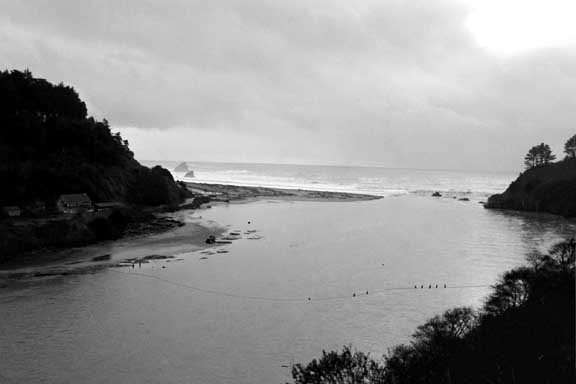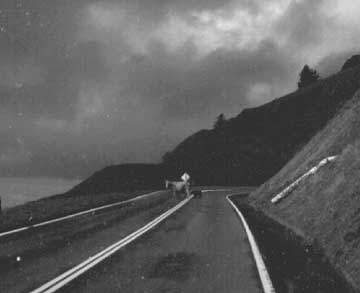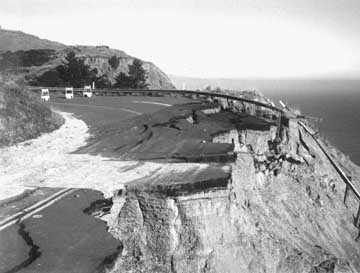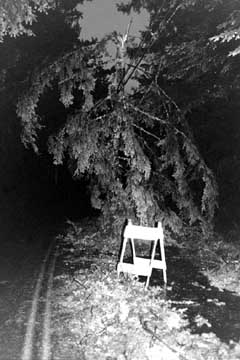TRAVEL SAFETY
CALIFORNIA NORTH COAST TRAVEL ADVISORY
The north coast of California is a fabulous place to visit. Any month of the year, nature orchestrates one of the greatest shows on earth! You can stroll expansive, driftwood scattered beaches; watch the drama of a fresh water river meeting the ocean; hike through a verdant coastal forest to the ledge between land and sea, go tide pooling or rock fishing; or watch the California gray whale migrations from a ringside seat at one of our fine coastal accommodations. The meaning of recreation often changes to re-creation.
During the summer, California State Highway 1 is the busiest two-lane state highway in California. Wintertime is the best time to vacation here. The highway often slows to a trickle of traffic and you can practically have the whole north coast to yourself. At cheery resorts in front of a crackling fire or from cozy rooms priced at special off-season rates you can revel in the security of riding out the wild Pacific Coast storms with their twenty foot breakers. A visit to the coast is more than a vacation - it's an adventure!
As a travel author I feel a responsibility for the safety of those encouraged by my books and websites to travel to this special part of California. Drownings, falls, collisions with other vehicles, livestock, or wildlife, and the possibility of having your dog shot by a sheep rancher are a few of the things that can and have happened to travelers and residents along the North Coast. Most ranchers are fine people who really care about good relationships with travelers. But occassionally you will find a "black sheep". On rare occassions frustrated ranchers who lost sheep to coyotes would ocassionally shoot a neighbors dog, put sheep fleece in its mouth and tell authorities "that dog killed my sheep"! Why? Revenge! Revenge against the newcomers who were elbowing the rancher's lifestyle and to collect in court for fabricated sheep kills. Also gone are the days when rednecks used to tye hippies to trees and shave their heads or push hippy campers off the cliffs into the sea late at night. One sheep rancher even bragged to me that in his life he shot "60 hippy dogs that got too close to his sheep". Needless to say he died years ago. If you loose a dog to a rancher confront them, ask to see the sheep the dog killed. You have recourse to felony animal abuse. Ranchers beware, for lots of travelers carry firearms, especially those in campers or RV's. Nowadays travelers have to worry more about arrogant and outlaw marijuna growers threatening them and their loved ones. These criminals set traps, put out poison and shoot dogs who are attracted to the smell of fertilizer and blood meal they use on their crops. If this happens to you then GPS the garden coordinates and "call in a DEA airstrike" and bust and jail these cruel people. Always use the feds as well as local law enforcement to avoid any cops who may be "too cozy" with the growers. Don't kid yourself. Marijuna which is grown in an environment of greed and violence is an addiction and gateway drug to lots of abuse on many many levels. Thoughtful and spiritually motivated growers gently and lovingly produce small quantities of superior medicine without the bloodshed and violence. Know the difference and help create a love motivated society.
The days are gone when a resort owner could say, "Don't tell 'em that. They might not come." Today's traveler expects and deserves to be told the truth. All the truth - full disclosure. Here are a few ground rules for those who will be exploring the beaches and woods along California's North Coast.
ROADS, TRAFFIC and DRIVING
The amount of traffic along Route 1 has increased dramatically over the past few decades. Old-timers may still remember the days when they would go to their window to see who was passing by on the highway, but the times are long gone when four or five cars a day used the road.  Now, on a summer weekend it's more like four or five cars a minute. Whether these coastal roads are adequate to the demand being placed on them is a serious question.
Now, on a summer weekend it's more like four or five cars a minute. Whether these coastal roads are adequate to the demand being placed on them is a serious question.
The important thing to remember is that it takes a different attitude to drive these roads. You are not on a freeway. Some of the locals have a harder time remembering that than the visitors. Some "poke along" and try to control others who are in a hurry and become nothing more than an obstacle and safety hazard. Still others speed along for the sheer pleasure of trying out their driving skills and the performance of their vehicle. Differing intentions make safe driving a special challenge on two lane rural roads. The usual rules and common courtesies are all the more required under these conditions. Pull over if you are holding up someone else. Expect the unexpected around every blind curve. Expect an oncoming vehicle on your side of the road when you go around a curve and you will be ready for it if it happens.
The traffic on State Highways 1, 20, 128 and others is very diversified ranging from log trucks (usually April 1 through October 1), RV motorhomes, large delivery trucks, high speed sports cars, cafe' motorbikes, 4-wheel drive trucks, family cars and 10-speed bicyclists in their Pacific Coast bicycle lanes. Accidents are inevitable, all are unnecessary. Cafe' or "ninja" bikers often suffer brain concussions and severed knee caps and elbows when they miss a curve and slide under a oncoming vehicle.
Log trucks usually run with the most frequency in the summer and fall. The drivers of heavy rigs are usually excellent. However, sometimes they get pushy and arrogant and will run down or over anything in their way including bear cups, deer, dogs, cats and your car. Financial pressure and a few beers or drugs takes them beyond good highway safety etiquette and they follow too close. If this happens, then pull over and wave them by to defuse the situation. Sometimes thats all it takes to defuse their anger and save the life of a wild animal or loved one from their frustration and anger. If the truck driver is unreasonable then take the truck company name and number and call the dispatcher or the California Highway Patrol and report the incident. Bust em, fine em and get them off the road! Don't stand for highway abuse - your action WILL save precious life. Remember, because these 18-wheel trucks and trailers are so long and heavy it takes them longer to brake and slow down, and they need much larger turning areas around corners than a standard car.
RV motorhomes are exceptionally slow. There are numerous pull-offs for vehicles to stop and ponder the natural beauty of our unspoiled coast‹use them! It's a California law for slower moving vehicles with five or more cars behind them to pull over to the right and allow traffic to safely pass. It is usually safe for RV's, vans, or cars to spend the night in pull-offs along rural highways. Be sure to set the brake! Also keep track of where the next gas station is and how much gas you have on board. Many rural coastal service stations close at 6 pm winters, 9 pm in the summer.
OPEN RANGE:  The fifteen miles between Jenner and Fort Ross on State Highway 1 marks the most unforgivable coastal stretch of highway in Northern California. Besides the diversity of traffic, there are sheer cliffs with few guard rails, and in some places it's 900 feet down a near vertical cliff to crashing waves and boulder-strewn beaches. Many have been severely injured or killed and some have never been found. As if that's not bad enough, it's still under open range law, which means unpredictable sheep and cattle can lay in the road or sporadically mosey across in front of your vehicle day or night, rain or shine, foggy, or clear. On overcast or foggy days and dark rainy nights I have even seen 2,000 pound jet black bulls standing in the middle of the road - almost impossible to see unless their eyes reflect your car lights. If you hit one of these poor animals, then you must pay for it's death or injury, plus the damages to your vehicle and occupants. It doesn't matter if you or a loved one are seriously injured - the rancher still expects to collect. It's under "Open Range Jurisdiction". To allow open range on a lonely or little traveled stretch of highway is one thing, but to allow it on State Highway 1, one of the busiest two-lane state highways in California, is a blatant and inexcusable disregard for public safety and animal welfare. Furthermore, the grazing by sheep along Highway 1 has reduced the ability of a traditionally unstable soil base to retain water which has contributed to highway washouts costing the taxpayers millions of dollars in upkeep and repairs. Removing the sheep, who chew grass down to the roots, and replanting oaks and vegetation would help stabalise the slopes and cliffs saving lots of money.
The fifteen miles between Jenner and Fort Ross on State Highway 1 marks the most unforgivable coastal stretch of highway in Northern California. Besides the diversity of traffic, there are sheer cliffs with few guard rails, and in some places it's 900 feet down a near vertical cliff to crashing waves and boulder-strewn beaches. Many have been severely injured or killed and some have never been found. As if that's not bad enough, it's still under open range law, which means unpredictable sheep and cattle can lay in the road or sporadically mosey across in front of your vehicle day or night, rain or shine, foggy, or clear. On overcast or foggy days and dark rainy nights I have even seen 2,000 pound jet black bulls standing in the middle of the road - almost impossible to see unless their eyes reflect your car lights. If you hit one of these poor animals, then you must pay for it's death or injury, plus the damages to your vehicle and occupants. It doesn't matter if you or a loved one are seriously injured - the rancher still expects to collect. It's under "Open Range Jurisdiction". To allow open range on a lonely or little traveled stretch of highway is one thing, but to allow it on State Highway 1, one of the busiest two-lane state highways in California, is a blatant and inexcusable disregard for public safety and animal welfare. Furthermore, the grazing by sheep along Highway 1 has reduced the ability of a traditionally unstable soil base to retain water which has contributed to highway washouts costing the taxpayers millions of dollars in upkeep and repairs. Removing the sheep, who chew grass down to the roots, and replanting oaks and vegetation would help stabalise the slopes and cliffs saving lots of money.
The greatest factor to all this lies silently in the ocean trenches awaiting God's command. A major shake would shave these slopes down to the shoreline, permanently removing this stretch of highway from the guidebooks. The slopes need to be reforested or the highway will no doubt permanently wash out as it did at Boiler Gulch (just north of Jenner) in March of 1983. There is also a remote, but none the less real threat of a long overdue 100+ foot tsunami.  It has happened in the past - indeed a whole redwood forest broke off the Humboldt coast several hundred years ago and is beneath the sea. A tusnami is in the back of the minds of many experienced emergency providers. If you are in a major ground shaker and are along the coast; you have about 2 minutes (on average) to get a minimum of 50 feet above the sea. Tusnami's travel at 100's of miles per hour before they hit the shoreline.
It has happened in the past - indeed a whole redwood forest broke off the Humboldt coast several hundred years ago and is beneath the sea. A tusnami is in the back of the minds of many experienced emergency providers. If you are in a major ground shaker and are along the coast; you have about 2 minutes (on average) to get a minimum of 50 feet above the sea. Tusnami's travel at 100's of miles per hour before they hit the shoreline.
Flooding, rock slides and "black ice" are a few of the other safety factors to be concerned about. If you see water over the road stop and get out of your car and check the current and depth. Do not attempt a night crossing - it can be way too dangerous. Many car loads of people have been swept into raging creeks and drown so be very very careful. Check the tide tables for low tide. Coastal creeks are lower then and many old timers have learned to "drive by the tides." During stormy weather it is always best to drive by daylight.
When Earl Thollander wrote his book "The Back Roads of California" he stated that "the best roads followed the contours of the land." These are "process oriented roads" which can bring relaxation and meditative introspection. Freeways are destination highways.  During the evolution of travel, hoof and paw gave way to moccassion and mountain boot followed by horse shoe and wagon wheel and finally automobile tires. Wildlife trails became paths which became roads and highways. The older the road the more common sense was used in creating it. The older roads followed the ridgetops and were not susceptible to flooding. Chances are when all the "newfangled highways" are under water like State Highway 1, 20 and 128, the old native American and pioneer trails will be high and dry. You will still have to look out for downed trees, power lines and boulders on the road. These roads become the only option cautious drivers have to get their loved ones in and out of their destinations. Innkeepers and rental agents will know which routes are safest and how to coach you to get in and out. Another option is to go exploring by chartered limo with an experienced driver who knows the roads well. Blessings and happy travels!
During the evolution of travel, hoof and paw gave way to moccassion and mountain boot followed by horse shoe and wagon wheel and finally automobile tires. Wildlife trails became paths which became roads and highways. The older the road the more common sense was used in creating it. The older roads followed the ridgetops and were not susceptible to flooding. Chances are when all the "newfangled highways" are under water like State Highway 1, 20 and 128, the old native American and pioneer trails will be high and dry. You will still have to look out for downed trees, power lines and boulders on the road. These roads become the only option cautious drivers have to get their loved ones in and out of their destinations. Innkeepers and rental agents will know which routes are safest and how to coach you to get in and out. Another option is to go exploring by chartered limo with an experienced driver who knows the roads well. Blessings and happy travels!
ABOUT THE PHOTOS: 1. Cow and calf cross in "Open Range Area" of State Highway 1 between Jenner and Fort Ross / Sonoma County. 2. Washout on State Highway 1 between Jenner and Gualala / Sonoma County. 3. Navarro River at flood stage. Highway 128 is closed and the only roads that are usually above flooding are the old pioneer roads, now paved such as Elk - Philo Road in Mendocino County. 4. Fallen trees, power lines and rock slides are common place during fierce winter storms. Pictured here is tree over power line on remote Elk-Philo Road after winters first heavy rains / Mendocino County.